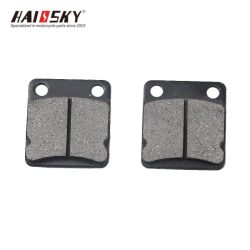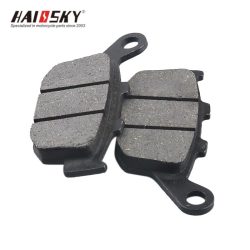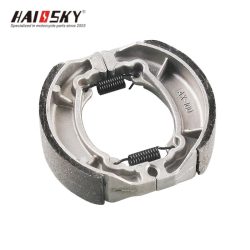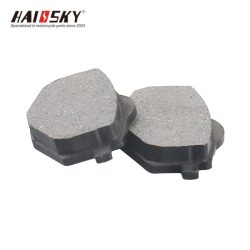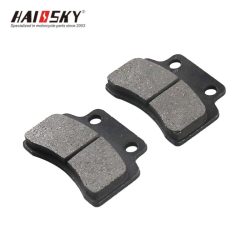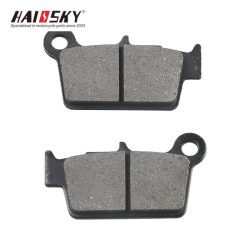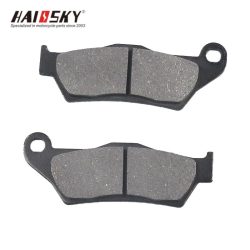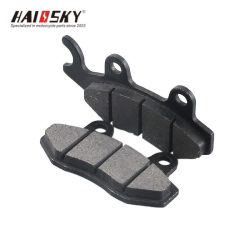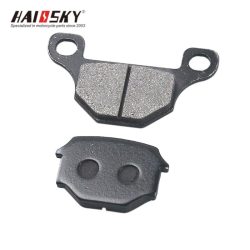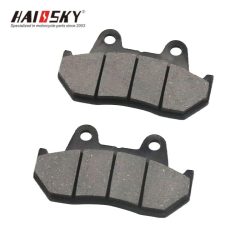OEM Motorcycle Parts
Category: Motorcycle Brake Shoes & Pads - Ceramic & Organic
The Ultimate Guide to Motorcycle Brake Shoes & Pads: Everything You Need to Know
When it comes to motorcycle safety, the braking system is one of the most critical components. Motorcycle brake shoes & pads are essential for ensuring your bike can stop effectively and safely, whether you’re navigating city streets or cruising on the highway. For B2B wholesalers and motorcycle enthusiasts, understanding the purpose, types, and maintenance of brake shoes and pads is essential. In this guide, we’ll dive deep into everything you need to know about motorcycle brake shoes and pads, while optimizing for the keyword “motorcycle brake shoes & pads” to help you make informed decisions for your business or customers.
What Are Motorcycle Brake Shoes & Pads?
Motorcycle brake shoes and brake pads are friction components that work with the braking system to slow down or stop the motorcycle. Brake shoes are used in drum brake systems, where they press against the inside of a brake drum to create friction. Brake pads, on the other hand, are used in disc brake systems, where they clamp onto a rotating disc (rotor) to create stopping power. Both components are critical for ensuring safe and reliable braking performance.
Types of Motorcycle Brake Shoes
Brake shoes come in various types, each designed to meet specific performance and durability needs. Here’s a breakdown of the most common types:
1. Cast Iron Brake Shoes
Cast iron brake shoes are the most common type, known for their durability and ability to handle heavy loads. They provide excellent braking performance in both wet and dry conditions but can be noisy and have limited heat dissipation capabilities.
2. Composite Brake Shoes
Composite brake shoes are made from a combination of materials like carbon, Kevlar, or ceramic. They offer high-performance characteristics, such as consistent friction coefficients and low wear rates, making them ideal for high-performance motorcycles or specialized applications.
3. Aluminum Brake Shoes
Aluminum brake shoes are lightweight and offer excellent heat dissipation, making them suitable for racing or off-road riding. They also provide good corrosion resistance, which is beneficial in humid or coastal environments.
4. Carbon-Fiber Reinforced Polymer (CFRP) Brake Shoes
CFRP brake shoes are made from a polymer reinforced with carbon fibers, offering high strength, stiffness, and weight reduction. They are commonly used in high-performance motorcycles where weight reduction and braking performance are critical.
Types of Motorcycle Brake Pads
Brake pads also come in various types, each designed for specific riding conditions and performance needs. Here’s a breakdown of the most common types:
1. Organic Brake Pads
Organic brake pads are made from materials like rubber, glass, and Kevlar. They are quiet, provide smooth braking, and are gentle on brake discs. However, they wear out faster and may not perform well under extreme conditions.
2. Sintered Brake Pads
Sintered brake pads are made from metallic particles fused under high pressure and heat. They are highly durable, perform well in wet conditions, and offer excellent heat resistance. However, they can be noisy and may wear out brake discs faster.
3. Ceramic Brake Pads
Ceramic brake pads are made from ceramic fibers and filler materials. They offer excellent braking performance, low noise levels, and minimal wear on brake discs. They are ideal for high-performance motorcycles but tend to be more expensive.
How Often Should Motorcycle Brake Pads Be Changed?
The lifespan of brake pads depends on factors like riding style, road conditions, and the type of brake pads used. On average, brake pads should be replaced every 10,000 to 20,000 miles. However, it’s essential to inspect them regularly and replace them when they reach the manufacturer’s recommended wear limit, typically around 2-3mm of remaining material.
How Much Should Motorcycle Brake Pads Cost?
The cost of motorcycle brake pads varies depending on the type, brand, and quality. On average:
Organic Brake Pads:
20
t
o
20to50 per set
Sintered Brake Pads:
30
t
o
30to70 per set
Ceramic Brake Pads:
50
t
o
50to100 per set
For B2B wholesalers, purchasing in bulk can significantly reduce costs.
Who Makes the Best Motorcycle Brake Pads?
Several brands are known for producing high-quality motorcycle brake pads, including:
EBC Brakes
Brembo
Galfer
Vesrah
SBS Friction
These brands offer a range of brake pads designed for different riding styles and performance needs.
How Do I Know if My Motorcycle Brake Shoes Need Replacing?
Signs that your brake shoes need replacing include:
Reduced Braking Performance: The motorcycle takes longer to stop or requires more effort to brake.
Noises: Squeaking, grinding, or scraping noises when braking.
Visible Wear: The friction material on the brake shoes is worn down or damaged.
Brake Drum Damage: Scoring or grooves on the inside of the brake drum.
How to Tell if Motorcycle Brake Pads Are Bad
Signs of bad brake pads include:
Squealing or Grinding Noises: Indicates worn-out or damaged brake pads.
Reduced Stopping Power: The motorcycle takes longer to stop or feels less responsive.
Vibration: Vibrations in the brake lever or pedal during braking.
Visible Wear: The brake pads are thinner than the manufacturer’s recommended limit.
How Hard is it to Change Brake Pads on a Motorcycle?
Changing brake pads on a motorcycle is a relatively straightforward process that can be done with basic tools. Here’s a step-by-step guide:
Tools Needed:
Socket wrench
Allen keys or hex wrench
Brake cleaner
C-clamp or brake piston tool
Steps:
Prepare the Motorcycle: Secure the bike on a stable surface using a paddock stand or center stand.
Remove the Wheel: Loosen the axle nut and remove the wheel to access the brake caliper.
Remove Old Brake Pads: Unscrew the bolts holding the brake caliper and remove the old brake pads.
Compress the Brake Pistons: Use a C-clamp or brake piston tool to push the pistons back into the caliper.
Install New Brake Pads: Insert the new brake pads into the caliper and secure them with bolts.
Reassemble the Wheel: Reattach the wheel and tighten the axle nut.
Test the Brakes: Pump the brake lever a few times to ensure proper alignment and functionality.
Maintenance Tips for Motorcycle Brake Shoes & Pads
To ensure your brake shoes and pads last as long as possible, follow these maintenance tips:
Regular Inspection: Check brake shoes and pads for signs of wear, damage, or corrosion.
Clean Brake Components: Use a brake cleaner to remove dirt, dust, and debris from the brake shoes, pads, and drums or discs.
Replace Worn Parts: Replace brake shoes and pads when they reach the manufacturer’s recommended wear limits.
Check Brake Fluid: Inspect the brake fluid level and replace it periodically to maintain optimal performance.
Lubricate Moving Parts: Apply high-temperature grease to caliper slides and pins to ensure smooth operation.
Test Brake Functionality: Regularly test the brakes to ensure they are responsive and provide adequate stopping power.
How to Choose the Right Motorcycle Brake Shoes & Pads
When selecting brake shoes and pads for your inventory or customers, consider the following factors:
Compatibility: Ensure the parts match the motorcycle’s make, model, and braking system.
Material: Choose high-quality materials like sintered metal or ceramic for better performance and durability.
Performance Needs: Select parts that meet the rider’s performance requirements, whether for commuting, touring, or racing.
Brand Reputation: Opt for reputable brands known for producing reliable and high-performance brake components.
Ease of Installation: Choose parts that are easy to install and come with all necessary hardware.
Warranty and Support: Look for parts backed by a warranty and manufacturer support for added peace of mind.
FAQs About Motorcycle Brake Shoes & Pads
Q: How often should I replace my brake shoes?
A: Brake shoes should be replaced when they show signs of wear or damage, typically every 10,000 to 20,000 miles.
Q: Can I use sintered brake pads on any motorcycle?
A: Sintered brake pads are compatible with most motorcycles but may wear out brake discs faster. Always check compatibility with your bike’s braking system.
Q: What’s the difference between organic and ceramic brake pads?
A: Organic pads are quieter and gentler on discs but wear out faster. Ceramic pads offer excellent performance, low noise, and minimal wear but are more expensive.
Final Thoughts
Motorcycle brake shoes & pads are essential for ensuring your bike stops safely and effectively. By understanding their purpose, types, and maintenance requirements, you can keep your customers’ motorcycles performing at their best. At Haissky.com, we offer a wide range of high-quality brake shoes and pads to meet the needs of B2B wholesalers and riders alike. Explore our catalog today and keep the roads safer!


